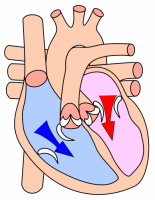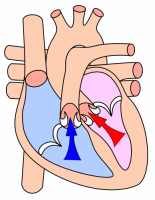Cardiac cycle

|
WikiDoc Resources for Cardiac cycle |
|
Articles |
|---|
|
Most recent articles on Cardiac cycle Most cited articles on Cardiac cycle |
|
Media |
|
Powerpoint slides on Cardiac cycle |
|
Evidence Based Medicine |
|
Clinical Trials |
|
Ongoing Trials on Cardiac cycle at Clinical Trials.gov Trial results on Cardiac cycle Clinical Trials on Cardiac cycle at Google
|
|
Guidelines / Policies / Govt |
|
US National Guidelines Clearinghouse on Cardiac cycle NICE Guidance on Cardiac cycle
|
|
Books |
|
News |
|
Commentary |
|
Definitions |
|
Patient Resources / Community |
|
Patient resources on Cardiac cycle Discussion groups on Cardiac cycle Patient Handouts on Cardiac cycle Directions to Hospitals Treating Cardiac cycle Risk calculators and risk factors for Cardiac cycle
|
|
Healthcare Provider Resources |
|
Causes & Risk Factors for Cardiac cycle |
|
Continuing Medical Education (CME) |
|
International |
|
|
|
Business |
|
Experimental / Informatics |
Editor-In-Chief: C. Michael Gibson, M.S., M.D. [1]; Assistant Editor(s)-in-Chief: Rim Halaby
Overview
Cardiac cycle is the term referring to all or any of the events related to the flow of blood that occur from the beginning of one heartbeat to the beginning of the next[1]. The frequency of the cardiac cycle is the heart rate. Throughout the cardiac cycle, the blood pressure increases and decreases.
Every single 'beat' of the heart involves three major stages that together form one cardiac cycle:
1- Atrial systole
2- Ventricular systole
3- Complete cardiac diastole
While the term systole is synonymous with contraction (movement or stretching) of a muscle, the term diastole is synonymous with relaxation of a muscle.
Atrial Systole
- Atrial systole is the contraction of the heart muscle (myocardia) of the left and right atria. Normally, both atria contract at the same time. The term systole is synonymous with contraction (movement or stretching) of a muscle.
- Electrical systole is the electrical activity that stimulates the myocardium of the chambers of the heart to make them contract.
- This is soon followed by Mechanical systole, which is the mechanical contraction of the heart.
- As the atria contract, the blood pressure in each atrium increases, forcing additional blood into the ventricles. The additional flow of blood is called atrial kick.
- Atrial kick is absent if there is loss of normal electrical conduction in the heart, such as during atrial fibrillation, atrial flutter, and complete heart block.
- Atrial kick is different in character when the condition of the heart is altered such as in the case of increased cardiac stiffness found in patients with diastolic dysfunction.

Detection of atrial systole
Ventricular Systole
- Ventricular systole is the contraction of the muscles (myocardia) of the left and right ventricles.
- Ventricular systole can be divided into two phases:
- Isovolumetric ventricular contraction:
- Ventricles contract and push the atrioventricular valves (mitral and tricuspid valves) to close.
- The pressure inside the ventricles rises but not enough to open the semilunar valves (aortic and pulmonary valves).
- The volume of blood inside the ventricles remain unchanged during this phase, hence the term "isovolmetric".
- Ventricular ejection:
- As the ventricles further contracts, the pressure inside the ventricle increases to a level that surpasses the pressure in the arteries.
- As the pressure in the ventricles is larger than that in the arteries, the aortic and pulmonary valves open and the blood is ejected outside the ventricles.
- During this phase, the pressure inside the ventricles is high and the volume of the blood in the ventricles decrease as it is ejected.
- Isovolumetric ventricular contraction:

Detection of ventricular systole
Heart sounds
- The first heart tone:
- The closing of the mitral and tricuspid valves (known together as the atrioventricular valves) at the beginning of ventricular systole cause the first part of the "lub-dub" sound made by the heart as it beats.
- Formally, this sound is known as the First Heart Tone, or S1.
- This first heart tone is created by the closure of mitral and tricuspid valve and is actually a two component sound, M1, T1.
- The second heart tone:
- The second part of the "lub-dub" (the Second Heart Tone, or S2), is caused by the closure of the aortic and pulmonic valves at the end of ventricular systole.
- As the left ventricle empties, its pressure falls below the pressure in the aorta, and the aortic valve closes. Similarly, as the pressure in the right ventricle falls below the pressure in the pulmonary artery, the pulmonic valve closes.
- The second heart sound is also two components, A2, P2: the aortic valve closes earlier than the pulmonic valve and they are audibly separated from each other in the second heart sound.
Electrocardiogram
- In an electrocardiogram, electrical systole of the ventricles begins at the beginning of the QRS complex.
Complete Cardiac Diastole
- Cardiac Diastole is the period of time when the heart relaxes after contraction in preparation for refilling with circulating blood.
- Ventricular diastole is when the ventricles are relaxing, while atrial diastole is when the atria are relaxing. Together they are known as complete cardiac diastole.
- During ventricular diastole, the pressure in the (left and right) ventricles drops from the peak that it reaches in systole.
- When the pressure in the left ventricle drops to below the pressure in the left atrium, the mitral valve opens, and the left ventricle fills with blood that was accumulating in the left atrium.
- Likewise, when the pressure in the right ventricle drops below that in the right atrium, the tricuspid valve opens, and the right ventricle fills with blood that was accumulating in the right atrium.

Regulation of the Cardiac Cycle
- Cardiac muscle is myogenic, which means that it is self-exciting. This is in contrast with skeletal muscle, which requires either conscious or reflex nervous stimuli for excitation.
- The heart's rhythmic contractions occur spontaneously, although the frequency or heart rate can be changed by nervous or hormonal influences such as exercise or the perception of danger. For example, the phrenic nerve accelerates heart rate and the vagus nerve decelerates heart rate.
- The rhythmic sequence of contractions is coordinated by the sinoatrial (SA) and atrioventricular (AV) nodes.
- The sinoatrial node, often known as the cardiac pacemaker, is located in the upper wall of the right atrium and is responsible for the wave of electrical stimulation that initiates atrial contraction by creating an action potential.
- Once the wave reaches the AV node, situated in the lower right atrium, it is delayed there before being conducted through the bundles of His and back up the Purkinje fibers, leading to a contraction of the ventricles. The delay at the AV node allows enough time for all of the blood in the atria to fill their respective ventricles.
- In the event of severe pathology, the AV node can also act as a pacemaker; this is usually not the case because their rate of spontaneous firing is considerably lower than that of the pacemaker cells in the SA node and hence is overridden.
Related Chapters
- Apex beat
- Blood pressure
- Cardiac action potential
- Cardiac muscle
- Cardiac output
- Electrocardiogram
- Heart
- Systolic array (computer architecture)
- Ventricle
Cardiac Cycle Video
{{#ev:youtube|rguztY8aqpk}}
References
- ↑ Guyton, A.C. & Hall, J.E. (2006) Textbook of Medical Physiology (11th ed.) Philadelphia: Elsevier Saunder ISBN 0-7216-0240-1
External Links
- Interactive cardiac cycle. Interactivephysiology.com
- Cardiac cycle. University of Utah School of Medicine
- Heart sounds. ULCA School of Medicine
da:Hjertecyklus de:Diastole nl:Diastole nn:Diastole sv:Diastole